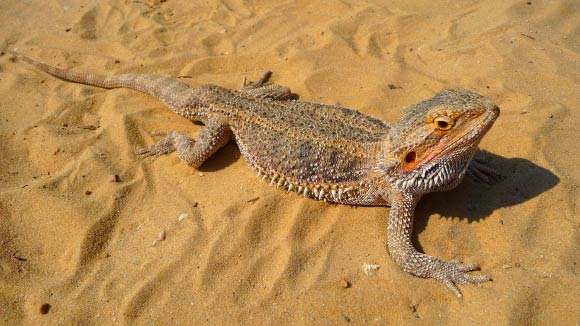A new study led by Dr. Gilles Laurent from the Max Planck Institute for Brain Research in Frankfurt, Germany, reveals slow-wave (SW) and rapid eye movement (REM) sleep patterns — the sleep patterns previously thought exclusive to mammals and birds — in a reptile, the central bearded dragon (Pogona vitticeps), suggesting that the sleep states may have evolved in a common ancestor of all amniotes, more than 300 million years ago.
Amniotes are a group of tetrapod vertebrates comprising reptiles, birds and mammals.
They appeared 320 million years ago, and quickly bifurcated into a group that led to the mammals, including humans, and another that led to the reptiles and the birds.
Bearded dragons are a type of lizard that branched out of the common reptilian trunk some 250 million years ago, much earlier than the branch that would lead to the dinosaurs and the birds.
According to Dr. Laurent and co-authors, a phenomenon observed in a reptile, a bird and a mammal would thus most likely have existed in their common ancestor.
In their report published in the journal Science, the scientists describe the existence of REM and SW sleep in the central bearded dragon, with many common features with mammalian sleep: a phase characterized by low frequency/high amplitude average brain activity and rare and bursty neuronal firing (SW sleep); another characterized by awake-like brain activity and rapid eye movements.
Another common feature with mammalian sleep was the coordinated activity of cortex with another area during slow-wave sleep: in dragons this other area is the so-called dorsal ventricular ridge. In mammals it is the hippocampus.
The team also reports interesting differences: for example, reptile sleep rhythm is extremely regular and fast: the reptile’s sleep cycle is about 80 seconds long at 27 degrees Celsius, vs. 30 minutes in cats or 60-90 minutes in humans.
Also, while in reptiles SW and REM sleep have roughly equal durations during each cycle, REM is much shorter then SW sleep in mammals, and both short and irregular in birds.
Overall, reptile sleep seems a lot simpler and may thus be closer to the ancestral mode of brain sleep.
“Although similar to mammalian sleep,” the scientists said, “reptile SW and REM resemble a stripped-down version of the richer mammalian repertoire.”
_____
Mark Shein-Idelson et al. 2016. Slow waves, sharp waves, ripples, and REM in sleeping dragons. Science, vol. 352, no. 6285, pp. 590-595; doi: 10.1126/science.aaf3621








